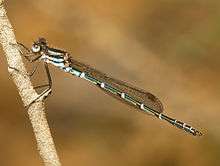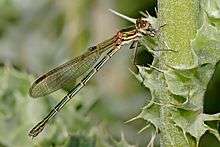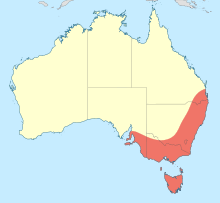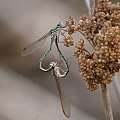Metallic ringtail
The metallic ringtail (Austrolestes cingulatus) is an Australian damselfly in the family Lestidae,[3][4] It is widely distributed in Tasmania, Victoria and eastern New South Wales.[5] It is a thin, medium-sized damselfly with a green and gold or bluish green and gold coloration. Each abdominal segment is marked by a pale "ring"; this, combined with its glossy metallic coloration, give it its common name of metallic ringtail.
| Metallic ringtail | |
|---|---|
 | |
| Male | |
 | |
| Female | |
| Scientific classification | |
| Kingdom: | Animalia |
| Phylum: | Arthropoda |
| Class: | Insecta |
| Order: | Odonata |
| Suborder: | Zygoptera |
| Family: | Lestidae |
| Genus: | Austrolestes |
| Species: | A. cingulatus |
| Binomial name | |
| Austrolestes cingulatus (Burmeister, 1839)[2] | |
 | |
It is active through October to March in still-water bodies such as rivers, lakes, ponds, swamps, and alpine bogs, being usually found amongst vegetation.
Gallery
 Mating pair
Mating pair.jpg) Female wings
Female wings.jpg) Male wings
Male wings
gollark: Thus apiobees.
gollark: If you have Intel graphics you're probably running open source drivers.
gollark: Proprietary software developers can do hilariously stupid things too!
gollark: It's not very secret at this point.
gollark: No, the Intel thing is the management engine.
See also
References
| Wikispecies has information related to Austrolestes cingulatus |
| Wikimedia Commons has media related to Austrolestes cingulatus. |
- Dow, R.A. (2017). "Austrolestes cingulatus". IUCN Red List of Threatened Species. 2017: e.T87534172A87539929. doi:10.2305/IUCN.UK.2017-1.RLTS.T87534172A87539929.en.
- Burmeister, Hermann (1839). Handbuch der Entomologie (in Latin and German). Berlin: T.C.F. Enslin. pp. 805–862 [823] – via Biodiversity Heritage Library.
- "Species Austrolestes cingulatus (Burmeister, 1839)". Australian Faunal Directory. Australian Biological Resources Study. 2012. Retrieved 10 April 2017.
- Theischinger, Günther; Hawking, John (2006). The Complete Field Guide to Dragonflies of Australia. Collingwood, Victoria, Australia: CSIRO Publishing. p. 34. ISBN 978 0 64309 073 6.
- Theischinger, Gunther; Endersby, Ian (2009). Identification Guide to the Australian Odonata (PDF). Department of Environment, Climate Change and Water NSW. p. 205. ISBN 978 1 74232 475 3.
This article is issued from Wikipedia. The text is licensed under Creative Commons - Attribution - Sharealike. Additional terms may apply for the media files.
